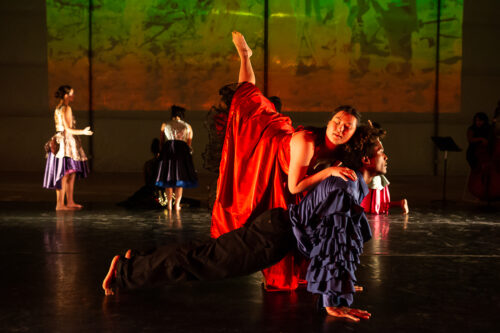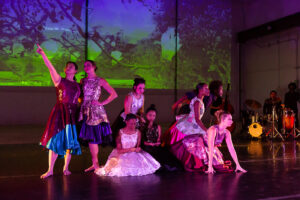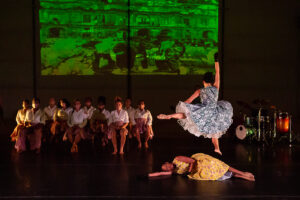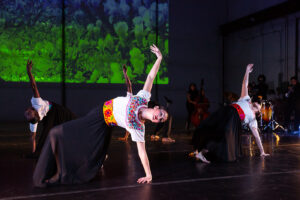The Hour is Coming, and It is Now: Adam Castaneda’s Lazarus in the Promised Land

Photo by Lynn Lane
On November 6 and 7, 2021 at The Storyhive, Adam Castaneda premiered Lazarus in the Promised Land, a brand-new, evening length work exploring the story of Castaneda’s paternal grandparents, Lazaro and Adelina, who, upon migrating in Houston from Mexico in the 1950s, became Jehovah’s Witnesses, raising their children and grandchildren in accordance with the denomination’s strict, separatist beliefs (Becker).
Lazarus opens to a triptych of women and men in evening attire, frozen in frame. A haunting projection of a family portrait, layered over an image of trees, watches from above. A live ensemble of musicians, visibly seen from the stage, envelopes the audience in a somber mood. As the dancers begin to gradually move into different poses, often in unison, the nature footage behind the family photo begins to move, giving the family a kind of immediate, dual presence.

Photo by Lynn Lane
All the dancers but two, a man and a woman, freeze in time. The man and woman seem to awaken to their moving presence, as if they’ve either left the underworld and returned to the living, or have been brought back to a previous time. At first, they slowly dance apart, with full luscious movements, and gradually embark on a duet together, at times dancing as partners; at others, dancing in unison with one another.
Slowly, the other dancers on stage come to life, and we watch the dancers move through six different movements of Castaneda’s family’s story of culture, migration, and faith. The costumes, designed by Ashley Horn, especially those worn by the women of Lazarus, make the movements sing with their vibrant colors and lush skirts. Castaneda’s impulse to create large circular motions for these choreographies, whether across the stage, or rolling against, it was a fitting one. The full-bodied dresses gave a flair of modern with the color choices and patterns while giving a sense of 1950s glamour and nostalgia. However, I would have liked to see the men’s costumes be given the same kind of playful attention and magic, both in their construction and design, to expand our notion of how one plays within the temporal spaces of now and then around Latinx masculinity.

Photo by Lynn Lane
The projections with their multiple layers of family portraits and nature footage, felt hauntingly apt, as I felt the spirits of Castaneda’s family hovering over the piece, as though they were watching this exploration of themselves, as much as we were. I particularly appreciated the movement of the projections itself, as yet another choreography lending itself to navigating this world of ancestry and pageantry.
Although I enjoyed the fluid round movements throughout the piece, in terms of both the choreography and the interpretation of the choreography, I found both a bit repetitive and lacking in range. In other words, I found myself longing for more textures, more moods, within this universe. Where was the sadness, the rage, the tension, the intergenerational “dialogue”? I wanted to see the expression of the movement as more of a wave, but I felt that each movement was embodied with the same levels throughout the piece, which made it difficult for me to connect to the shapes I imagined Castaneda was after as intently. Additionally, the choreography itself I felt could bring more complexities, more nuance, especially for a subject matter so rich with dimensions.
My largest critique of Lazarus in the Promised Land was an issue of narrative. I felt that the way the piece was structured in terms of movement, gesture, and vignette (not to mention the program notes regarding the six movements, individually titled) led to a possible narrative structure, but I found it incredibly difficult to figure out what that narrative was. I only knew when a movement ended and the next began based on very liminal context clues (Movement IV: The Congregation at Worship, for example, made sense to me because the stage was set as a congregation) but not from any other clear signs regarding action, character, emotion, conflict, or other signals of narratives, even for an abstract modern dance narrative. I think that if Castaneda were to revisit this piece, which I hope he does, that one could include more narrative detail in the program, or even offer some title slides with the projections so that we’re clear what important narrative moments viewers should connect to with each Movement. Another option that I think would be an intriguing exploration would be to throw out the program, bring in more choreographic and visual complexities on stage, and throw the narrative out completely. I will say that, although I appreciate the exploration of Castaneda’s grandparents migrating to America and finding themselves connected to Jehovah’s Witness, it wasn’t clear to me as a viewer. And perhaps isn’t necessary for the work to be powerful to others.

Photo by Lynn Lane
I would also love to see this piece set again at a different theater. I’m aware that MATCH is the best venue in town for independent dance artists, and that they’ve had a busy season across the performing arts, now that companies are able to perform safely again. The Storyhive was an interesting space, and large enough to feel safe to attend the performance during these difficult times of COVID safety. But I wasn’t able to see a great deal of the choreography on stage because of the conditions of this particular venue. If Castaneda performs at The Storyhive in the future, I’d recommend organizing the seating in a round structure, perhaps, so that it would be easier for more audience members to see more of the movement, especially the floorwork.
In closing, Adam Castaneda’s Lazarus in the Promised Land was a lovely tribute to personal history, family lineage, and faith, and thoughtfully combined modern dance movement, image projections, live music, and costume design to depict a reflection on Latinx culture and migration. I do sincerely hope that Castaneda is able to spend more time with these ideas in the future, as I would love to see a more thorough exploration of these ideas.



Recent Comments